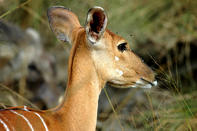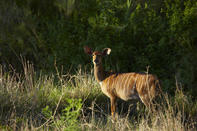Keeping Quiet

Nyala have small hooves for their body size. As they walk, the hind feet step into the position where the front feet have just been. This is known as registering and reduces the amount of noise made with each step.
The bases of the back of a nyala’s ears are white as is the underside of the fluffy tail which is raised when the animal takes fright. These devices are ‘follow me’ symbols that facilitate young in following after the adults.
The flash of the white tail also provides a stark target to a predator but as soon as the nyala stops, the tail is dropped and the predator’s focus is lost. The disruptive camouflage markings then come into play further concealing the nyala from the predators view so long as it remains still.
Lay Low

The thicket habitat of the nyala provides ideal cover for the calves when they are born. Nyala experience a lying up period for the first two to three weeks of their lives during which time they remain hidden to allow them to build up their strength before moving around with the adults.
The mother visits her calf to feed and groom it. If it becomes threatened, the calf instinctively flattens itself onto the ground and due to its lack of scent at such a young age, can easily avoid the attention of predators this way.
By Megan Emmett